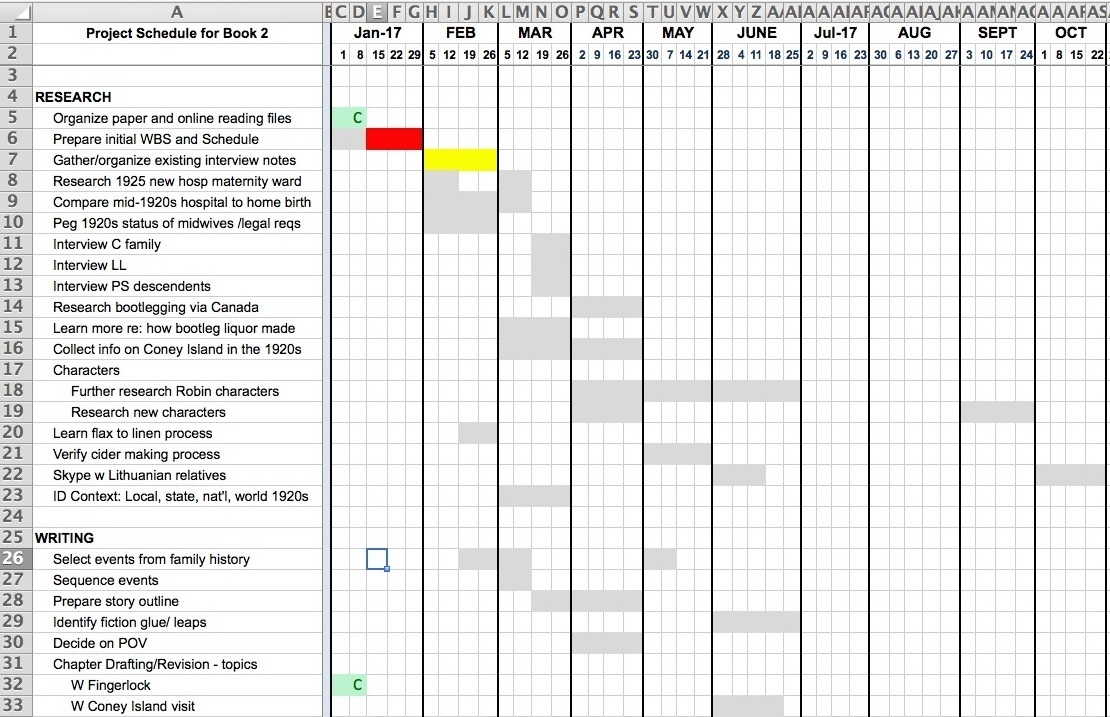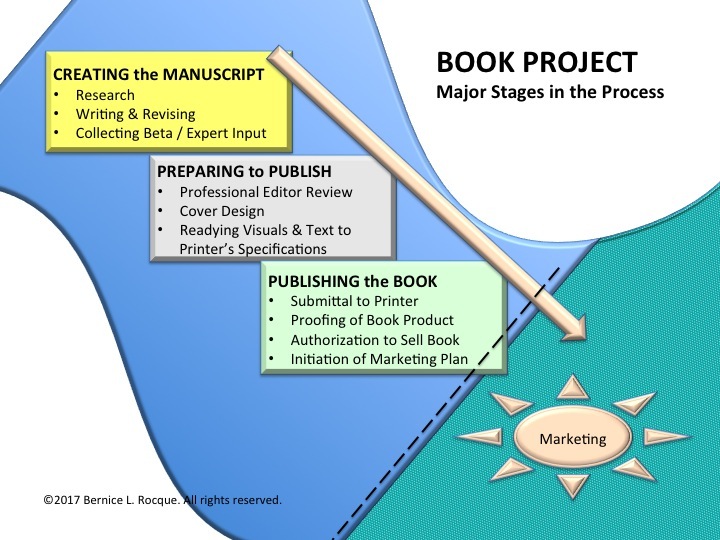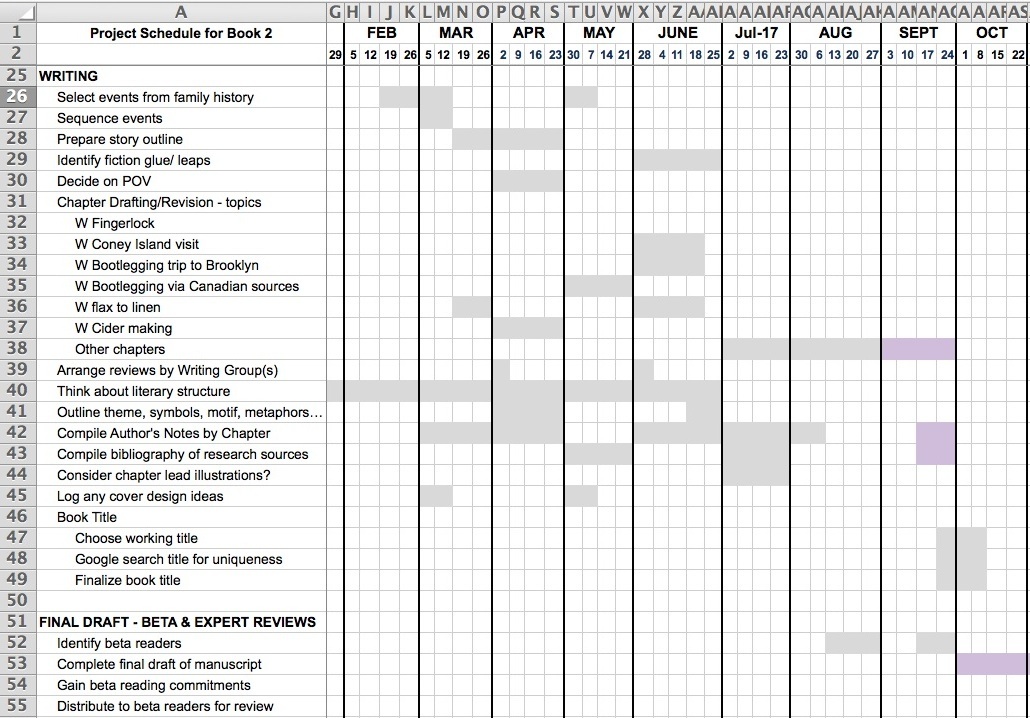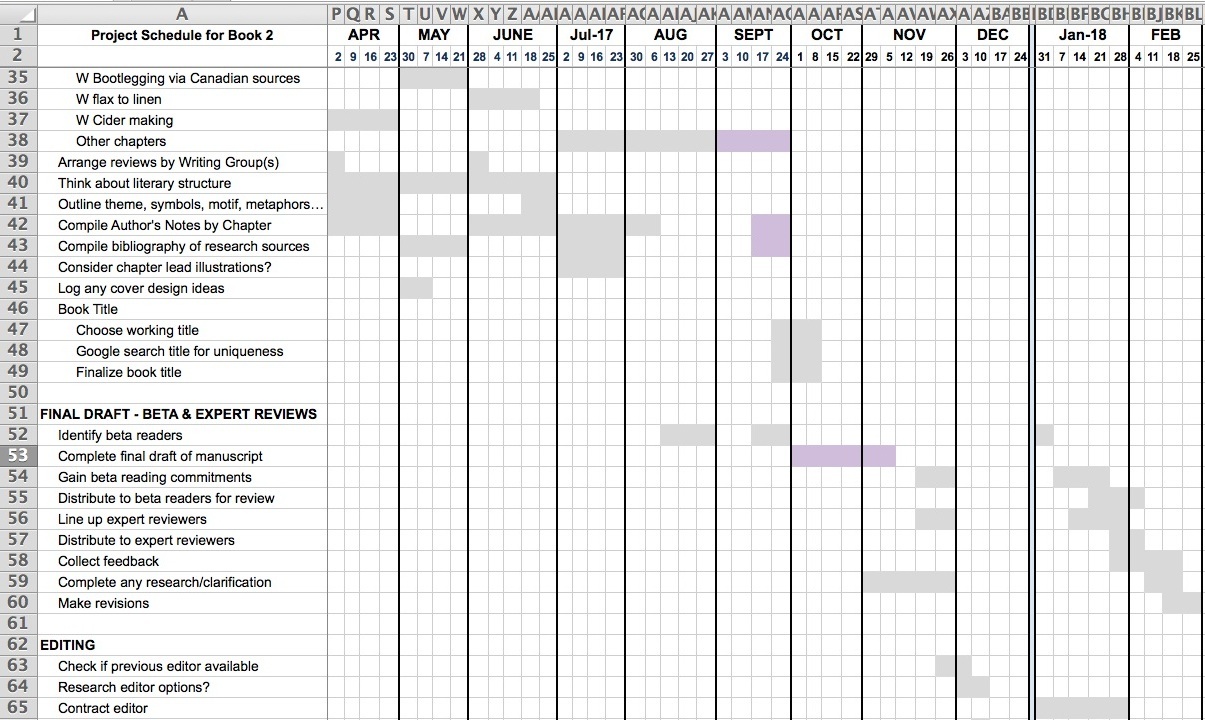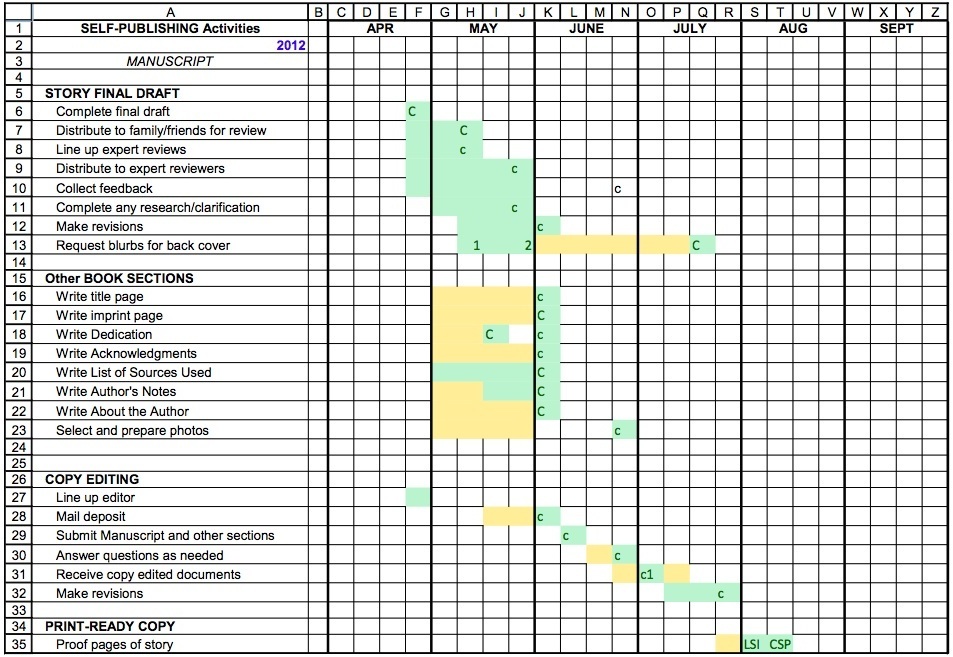Introduction
Are you a writer seeking better organization of your writing project(s) — but not if it feels like a straitjacket stifling your creativity? If you nodded, this article may help you.
This blog piece is the first in a series on how to create a “Lite” Schedule to better manage your book project. We’ll apply selected best practices from the Project Management field, but scale them to suit book projects.
We will use the Lite Schedule from my book in progress. It evolved from my 2012 book schedule and its learnings. If you are following this blog series, we can work in parallel, much like writing partners!
Destination: Lite Schedule for a Book Project
The Lite Schedule we will develop trades the stack of “To Do” lists for a 2-dimensional rendering of your project’s tasks and schedule. There are 3 major components:
– an organized list of tasks;
– a timeline; and
– a time band allocation for each task.
Exhibit 1: A sample portion of my Lite Schedule.
If you like charts, you’ll be in heaven. If not, don’t be intimidated! Stay with me; the concept may grow on you! Along the way, I will share a tips and cautions that may help you, especially if this is your first book.
If you are not familiar with Microsoft Excel, but you want to give this a try, work with a friend who is skilled. You could also mimic the approach using the Tables function of MSWord, but the spreadsheet is easier — especially when you begin to revise and update the schedule. Be brave! We will use basic features of MSExcel.
I imagine the MSExcel power users among you already jumped ahead, based on Exhibit 1. That is fine, but do read the rest of this article soon, as some of the guidance points may make a significant difference for you.
“Lite” as compared to what!
Technically, projects have a START and an END. In a book project, the start point is usually the decision to write a book. We will designate the end point to be the date when the book is available for purchase.
Project management success highly correlates with:
(a) defining a project well and early on; and
(b) bringing process discipline to the project’s activities.
If applied thoughtfully, this “lite” schedule approach will surface some tasks you would have missed. Using a Lite Schedule has worked for me, and I would love to see more authors reach their objectives with less frustration, and possibly a better book product.
In the project management field, experienced professionals (PMs) often “scale” method tools (such as a Schedule) to the complexity, cost, and risk levels of a particular project. Otherwise, the time required (labor = expense) by heavy method erodes value, reducing the financial benefits. As an example, a $30 million dollar technology project might employ a Project Schedule exceeding 100 printed pages to control an enormous amount of resources, as well as task interdependencies. For that level of investment, the time spent on rigorous method is prudent.
In general, book projects are far less complex. If you’ve relied on “To Do” lists in the past to manage work efforts, a “lite” schedule of 3-10 (printed) pages may seem like more effort at first, but I assure you, it will become a reliable friend as you begin to use it.
If you feel like you have been in a perpetual muddle for a while and are not making the progress you want, the Lite Schedule can bring concreteness to your writing and publishing tasks. You will notice the change over the months — as if you’ve become a stone mason and the beautiful stone patio you have sketched is materializing before your eyes.
Any genre?
Though my first book is historical fiction, I believe the approach described in this article applies to either a work of fiction or non-fiction. If you are writing in a different genre, you can adapt the list of tasks. For example, if you are penning a textbook, you’ll probably want to amplify the tasks associated with preparing your illustrations.
Just as you and I will revise our manuscripts numerous times, we can both expect to keep refining the Lite Schedule as we progress. Plan to invest 30-60 minutes weekly reviewing your schedule and updating its activities. This commitment is essential to ensure an accurate picture of current status, prior to determining priorities for the week ahead.
So…are you ready to try this approach? By the end of this blog series, you will be able to develop an organized list of tasks for your book project, plan time to work on each task, adjust your schedule if needed, and track your progress towards an overall finish date you have set. For the latter, we’ll even apply a special “stoplight” for alerts!
If you diligently develop your task-based schedule and stick with it, the chances that you reach your goal to publish the book are very good —and the quality of your book may even be improved…
The Flow of the Book Project
Think of a book project as a river. Imagine you are standing at the top of a mountain, filled with the sunshine of your book idea. You can barely see the descent of the narrow mountain stream. It becomes wider and more visible as it meanders through a changing landscape. In the distance you can see it flow into the sea.
Exhibit 2. The book project’s major stages flow like a river.
The river’s source includes Research, Writing, and Final Draft clusters. Along the middle streaming twists and turns, the growing river welcomes important tributaries, like Professional Editing, Cover Design, and Preparing the Manuscript for Printing.
The river’s delta deposits our book into the Printer’s shop. Once Authorized, it is released into the sea of competition — the marketplace. It is here that the Marketing Plan strategies and tactics, ownership issues, and reader discovery/reception propel or disable book sales.
Once you see the power of truly managing your book project, you could make a decision at book release to execute your book’s Marketing Strategy/Plan over a specific period of time, such as 18 months. With specific START and END dates, the marketing endeavor could be deemed a project, and managed as such! An idea worth noodling — if you want to apply the same kind of focus to maximize discovery and sales success.
Clustering Book Project Tasks
Do you remember struggling with what seemed a gargantuan school project when you were a young student? What did a teacher or parent suggest?
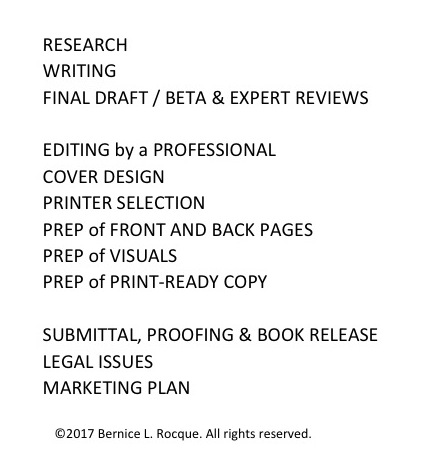 Probably to “break it into smaller chunks.” That is exactly what we want to do with our book projects, too!
Probably to “break it into smaller chunks.” That is exactly what we want to do with our book projects, too!
We’ll call these chunks “Process Clusters.”
By organizing the chunks of work into logical and sequenced processes, we increase the likelihood of project success.
The clusters, left, will gather the related tasks of our book project. The order, top to bottom in Exhibit 3, reflects the start to finish sequence of a book project’s major activities.
Exhibit 3: The Process Clusters of a Book Project.
By the way, most professional project managers (PMs) would point out that an important activity is missing: preparing a Business Case. That is, analyzing the book project’s likely costs and risks vs. its likely revenues — to determine whether or not to make an investment in this book.
So then, why did I exclude a Business Case cluster from our Schedule? The short answer is: since the Lite Schedule reflects a simpler project management process, performing a rigorous cost/benefits/risk analysis would trade too much time for too little value. Here are the main reasons.
First, commercial authors who crank out one or two books a year already understand much of the financial equation. In my conversations with authors newer to publishing, though, especially writers of fiction, it seems they perceive the book effort to be a personal objective and rarely discuss value vs. costs (including their own labor) and risk. Second, once a writer decides to publish a manuscript, it becomes clear with a little research that essential out-of-pocket start-up costs (editor, cover designer, printing) can be surprisingly modest. Third, the menu of book marketing options is diverse, both in approach and cost.
The way I will leave this Business Case subject is this. If the primary purpose for publishing a book is commercial, then do some analysis. If the primary purpose is personal, and you have chosen editors and cover designers wisely, you can break even with your out-of-pocket start-up costs by selling 300-500 paperback titles. If you actively market your book, watch marketing expenditures carefully, as their accumulation can surprise you — like a gentle snow that leaves you with 12 inches of snow to shovel.
How to Create your “Lite” Schedule
We are now going to dive into the “how-to” of creating the Lite Schedule. The exhibits should clarify and amplify the instructions.
STEP 1: Left side of your spreadsheet…
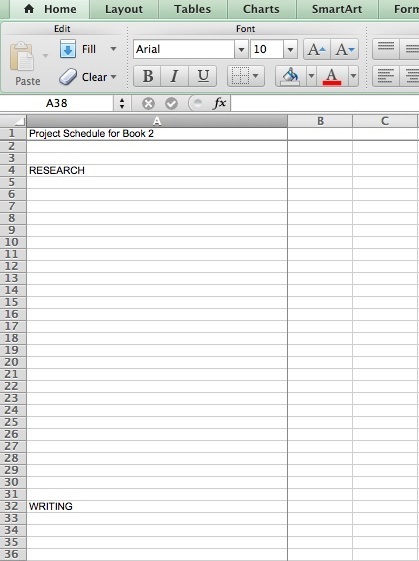 Widen the first empty column (“A”) to about 2 inches.
Widen the first empty column (“A”) to about 2 inches.
Enter your book project name in the first row of that first column. (My Lite Schedule reads Project Schedule for Book 2.)
Drop down 3 rows and enter the word, RESEARCH. Leave 30 blank rows.
Then, enter the word, WRITING. Leave 20-30 more blank rows.
Finally, enter FINAL DRAFT – BETA & EXPERT REVIEWS. (not shown)
Exhibit 4. Enter Process Cluster headings in the first column.
Please review my book’s RESEARCH, WRITING, and FINAL DRAFT cluster exhibits below. Typically, tasks at the top of a cluster will start earliest; those at the bottom of a cluster will begin later in the schedule. This sequencing will facilitate your weekly tracking. Can you spot the task in RESEARCH that should definitely be moved up?
Exhibit 5. The RESEARCH Cluster of tasks (initial draft).
Exhibit 6: The WRITING Cluster of tasks (initial draft).
Exhibit 7: The FINAL DRAFT Cluster of tasks (initial draft).
Do notice the Verb Object format for the most specific task you will track, such as “Organize research paper…” We will use a Noun or gerund if naming a subgroup of tasks. An example of this in my schedule is “Characters” as a subgroup in the RESEARCH cluster.
As you begin to add tasks, please ignore the time bands for now. We will give attention to those in Step 4, below.
In your RESEARCH cluster, begin to enter tasks. Retain my verbs where you can, but substitute the subjects you plan to research (or interview) in place of mine. Then, enter any additional research tasks you think you will need. Books usually take more time to read than articles, so do account for them. For example, if I decide to read more about Prohibition in the 1920s for my book project, I could add “Read 3 books on Prohibition” or list a separate task for each book.
In your WRITING cluster, repeat the process. Do refine the task list to reflect the style and sequence of how you prefer to write. Some writers outline or define exhaustively before they begin. Others, especially character-driven fiction writers, start with a situation and allow their characters to “write the story.” The latter style will have fewer tasks at the start of the project. As plot, themes, etc. reveal themselves, logging them as a new task will serve as a handy reminder for the remainder of the writing effort. An example of an added task might be: “Amplify sub-theme of determination.”
In your FINAL DRAFT cluster, again, draw from my task list and add any other tasks you will need. If you are unfamiliar with beta reviews, they build your customer and stakeholder network. But, more importantly, multiple and varied readers provide feedback on manuscript strengths, errors, confusion, etc. BEFORE your book is published. Google the subject for additional information about Beta Reviewers.
Now, “step back” and review the three Process Clusters (RESEARCH, WRITING, and FINAL DRAFT) you created so far. Insert any other subgroups or tasks in the sequence and check your indents, but don’t obsess. I promise you will move items around and also think of additional tasks once you begin to use the Lite Schedule. As a reminder, we will track only the most specific task level. The other levels help with context as you review the Lite Schedule each week.
Congratulations, you just drafted the initial task clusters of what professional project managers call the Work Breakdown Structure (WBS).
STEP 2: Top of your spreadsheet…
Refer to Exhibit 8, below, as you set-up your (horizontal) timeline.
First, narrow a big bunch of columns. Leave column (“B”) blank to the left of your first month.
Begin to structure the timeline with the “C” column. Caution: I started my Timeline with January 2017. If you are starting with a different month (or year), be sure to check a calendar for the week start dates you need. In Row 1 only, merge the appropriate number of cells for each month, and label the month name there. Then, enter the dates of each week start for that month.
 Exhibit 8: Structuring your Timeline.
Exhibit 8: Structuring your Timeline.
My Book 2 Lite Schedule covers 24 months, but yours can be shorter or longer. The decision about the span of your timeline can be firmed up as you proceed. If you are unsure, set up a year timeline for now. After you use the Lite Schedule for 3-4 months, you can more realistically set the END date for your project.
My 2012 book project timeline actually began deep into the WRITING Cluster — when I decided to publish my book via my existing business. The 6-month April-September project timeline covered the Final Draft to Authorizing span of activities. The completed Lite Schedule totaled 3 printed pages.
Yes, a rather short schedule, based on a serendipitous decision… My 80-something uncle had served as my primary story advisor for about 3 years, as I wrote the book part time. His milestone birthday sort of snuck up on me, but it became an opportunity to thank him and celebrate this amazing achievement in his life.
So, the objective was to give a paperback book to my uncle in honor of his 90th birthday, November 23, 2012. The “hard” deadline was Nov 1. The “soft” deadline, reflected in the Lite Schedule, was Sept 30. The optimistic deadline was Sept 1. I was able to authorize my book on Sept 8.
Each month of the 2012 book project, I dedicated time equivalent to a full time job — to finish the writing and bring the manuscript through Authorization. I did cut back some non-book activities in my life, where it was possible. Since this was a new type of project for me, I was researching/learning a lot about publishing as I progressed. So, I planned one month (October) of general contingency in case there were delays and the schedule slipped.
A page from my 2012 completed Lite Schedule is shown below as Exhibit 10.
STEP 3: Top left of your spreadsheet…
Now, park your cursor in the “B” column near the top of the spreadsheet — in the row above RESEARCH (to the left of your timeline).
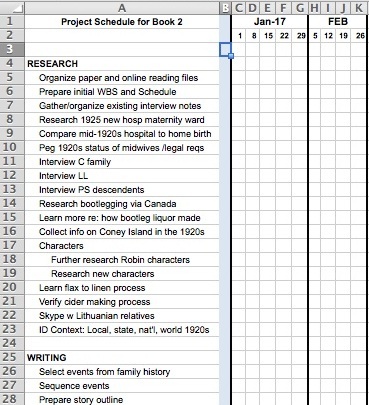 Then, click on WINDOW on the MSExcel top navigation bar and select Freeze Panes.
Then, click on WINDOW on the MSExcel top navigation bar and select Freeze Panes.
This is a handy feature that allows you to continue to see the Timeline’s heading rows as you scroll down, and conversely, the Task List as you are scrolling horizontally.
Do scroll up and down to ensure the effect is working properly.
If you have any difficulty, search Google for detailed instructions using the subject terms: MS Excel how to freeze panes.
Exhibit 9: Freeze Panes at cell location shown.
STEP 4: Center of the spreadsheet…
Next, you will assign time bands. How long do you expect to spend on each task and when will this work effort occur in your schedule? Please read the following background, tips, and cautions prior to adding your time estimates.
To keep our schedule “Lite,” we will not use the detail-intensive methods that professional project managers use on complex projects. Instead, we will apply duration estimating. I am calling it “time banding.”
You will color fill (I am using gray) the week or span of weeks you expect to be working on a particular task in your book project, whether you expect to spend a few hours or a hunk of time. As a reminder, each column in the Timeline equals one week.
As a comparison to our “lite” method, professional PMs use sophisticated project management software, like MS Project, to estimate how long a task will take and which member(s) of the project team will work on it. PMs connect tasks which are interdependent, and enter actual time expended each week on each task. An example of an interdependency is: you must receive an Expert Reviewer’s feedback before you can begin to make any revisions based on this feedback which you requested.
You can track actual time expended, too, if you wish, logging the number of hours in the first cell of the filled band and the actual in the cell where you complete the task. It might be an aid, especially in the first few months, to understanding whether the overall time you are actually giving to your project (weekly/monthly) matches what you hoped to give.
Once you have used your Lite Schedule for 4-8 weeks, you will gain a sense of what to juggle. Don’t hesitate to adjust. Even experienced PMs adapt to changing conditions over the months (or years) of the project.
Here are some specific tips about how color-coding can alert you. Exhibit 10 shows the first of three pages from my finished 2012 Lite Schedule.
Exhibit 10: Sample page from a completed Lite Schedule.
Earlier, I mentioned a “stoplight” for alerts. Well, notice the gray fill is gone on this page. The YELLOW fill signals caution. In Exhibit 10, as time was getting tight, I wanted to easily spot any tasks remaining in a certain time span. The GREEN fill signifies the task is done and the “C” shows when it was completed.
Have you figured out the significance of the RED fill? I change the fill color to RED for any task that needs my immediate attention, i.e., it is a high priority for the next week or so. (See Exhibit 1 in my current Lite Schedule for an example. While I have been writing this blog piece, that task was taking longer… It is now completed, but I decided to leave it for purposes of discussion here.
As far as recognizing interdependencies that have the potential to delay your book project, our schedule is compact enough for you to spot them —as long as you are diligent in keeping the tasks positioned in the order they are likely to occur. If there are a few interdependencies that concern you, code them in a fill color, perhaps in pale lavender, as shown in Exhibits 6-7.
Here is the major caution. Every writer has other activities in their life besides writing… Job, family, medical, travel, writing groups, house chores, social engagements, and unplanned events like illnesses need to be figured in. Ask yourself, generally, what percent of the waking hours of my week will I allocate to my book project? Be truthful with yourself!
So, if you can allocate only 15 hours per week (about 2 days) to your book project, make sure the time estimates reflect that allocation. If you discover you cannot give the time needed, there are many options. You can change the end date, or make adjustments in your non-book activities, or get some help from other people, either hired or volunteer(s).
Please do yourself a favor — don’t over pack the front of the schedule. This time band estimating approach quickly alerts you to where (in the schedule) you are probably overbooking yourself. In a vertical glance down a month’s column, you can see where you might need to shift activities earlier or later in the timeline.
If you have uncertainty about how much time a task will take, add contingency time. For example, block out 5 weeks instead of the 3 you were considering. All these time allocation decisions are yours to make.
By reviewing the exhibits, I think you’ll see how you might allocate your own schedule, even though yours will have differences, based on all the factors discussed in this blog piece.
Do notice the paralleling of some tasks, such as research and writing in Exhibit 5. Many authors prefer to finish research prior to beginning the writing. I have found interleaving the two quite convenient. At the other extreme, I know one fiction writer of some acclaim who writes the entire fiction manuscript, noting along the way what he needs to research. Once the manuscript is drafted, he researches and revises, as needed.
Working on tasks from two or more clusters in parallel does shorten your schedule. An ideal paralleling opportunity is the use of waiting time. For example, preparing the front and back pages of your prospective book while waiting for the feedback from beta and expert reviewers, as shown in Exhibit 10.
Tracking your Book Project
In the next part of this blog series, we will discuss preparing your manuscript for printing, tracking your progress against your Lite Schedule, and associated tips and cautions.
For now, start to use the Lite Schedule you created. If you need to ask a question, please go to the CONTACT page on this web site and send me a message. I try to respond within 3 days. BLR
Bernice L. Rocque, PMP, holds the Project Management Professional certification of the Project Management Institute. Her Young Adult book, Until the Robin Walks on Snow, fictionalizes her immigrant family’s determination and their midwife’s dedication to save a 1.5-pound newborn in 1922 Connecticut. For ages 10 and up, the story includes Eastern European Christmas traditions and themes of survival, family, faith, and friendship. Author Notes separate the facts, family history, and research behind the story.


